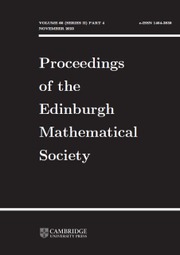No CrossRef data available.
Article contents
Multiple solutions to relativistic systems with potential boundary conditions
Published online by Cambridge University Press: 01 September 2025
Abstract
We consider potential systems of differential equations of the form \begin{equation*}-\left[ \phi(u^{\prime}) \right] ^{\prime} = \nabla_u F(t,u),\quad \mbox{in } [0,T],\end{equation*}
\begin{equation*}-\left[ \phi(u^{\prime}) \right] ^{\prime} = \nabla_u F(t,u),\quad \mbox{in } [0,T],\end{equation*} \begin{equation*}\left ( \phi \left( u^{\prime }\right)(0), -\phi \left( u^{\prime }\right)(T)\right )\in \partial j(u(0), u(T)),\end{equation*}
\begin{equation*}\left ( \phi \left( u^{\prime }\right)(0), -\phi \left( u^{\prime }\right)(T)\right )\in \partial j(u(0), u(T)),\end{equation*} $\phi(y)={y}/{\sqrt{1- |y|^2}}$ and
$\phi(y)={y}/{\sqrt{1- |y|^2}}$ and  $j:\mathbb{R}^N \times \mathbb{R}^N \rightarrow (-\infty, +\infty]$ is convex and lower semicontinuous. Making use of the variational approach introduced in the recent paper “Potential systems with singular
$j:\mathbb{R}^N \times \mathbb{R}^N \rightarrow (-\infty, +\infty]$ is convex and lower semicontinuous. Making use of the variational approach introduced in the recent paper “Potential systems with singular  $\phi$-Laplacian”, we obtain multiplicity of solutions when the action functional is even, as well as existence of multiple geometrically distinct solutions when this functional is invariant with respect to some discrete group.
$\phi$-Laplacian”, we obtain multiplicity of solutions when the action functional is even, as well as existence of multiple geometrically distinct solutions when this functional is invariant with respect to some discrete group.
MSC classification
Information
- Type
- Research Article
- Information
- Copyright
- © The Author(s), 2025. Published by Cambridge University Press on behalf of The Edinburgh Mathematical Society.


